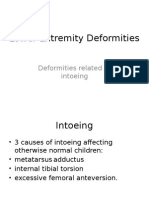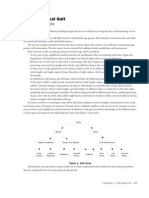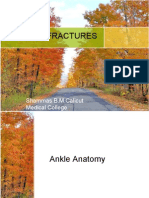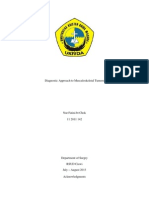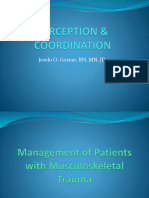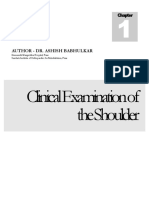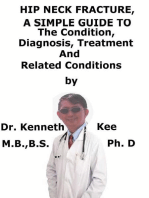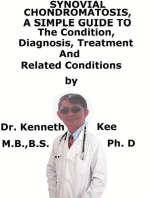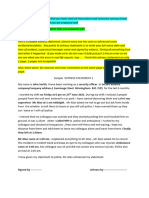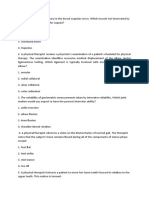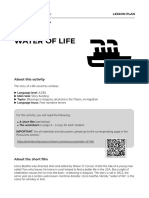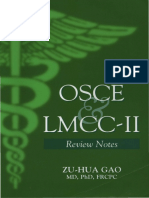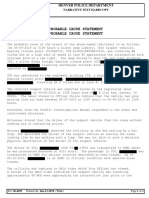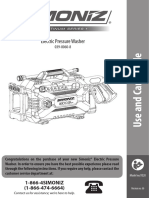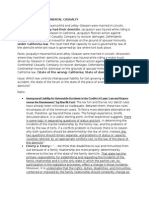0 ratings0% found this document useful (0 votes)
119 viewsHip Problems
Hip Problems
Uploaded by
Dhiya' VinaThis document discusses three common hip problems in children: slipped capital femoral epiphysis, Perthes disease, and developmental dysplasia of the hip. Slipped capital femoral epiphysis is a fracture through the growth plate of the upper femur and can lead to osteoarthritis if not treated. Perthes disease is avascular necrosis of the femoral head, more common in young boys, and management focuses on reducing pain and preventing deformity. Developmental dysplasia of the hip covers a range of abnormalities where the femoral head is not properly situated in the acetabulum, and treatment depends on age and severity, ranging from harnessing to surgery.
Copyright:
© All Rights Reserved
Available Formats
Download as PPT, PDF, TXT or read online from Scribd
Hip Problems
Hip Problems
Uploaded by
Dhiya' Vina0 ratings0% found this document useful (0 votes)
119 views46 pagesThis document discusses three common hip problems in children: slipped capital femoral epiphysis, Perthes disease, and developmental dysplasia of the hip. Slipped capital femoral epiphysis is a fracture through the growth plate of the upper femur and can lead to osteoarthritis if not treated. Perthes disease is avascular necrosis of the femoral head, more common in young boys, and management focuses on reducing pain and preventing deformity. Developmental dysplasia of the hip covers a range of abnormalities where the femoral head is not properly situated in the acetabulum, and treatment depends on age and severity, ranging from harnessing to surgery.
Original Description:
Hip Problems SCFE
Copyright
© © All Rights Reserved
Available Formats
PPT, PDF, TXT or read online from Scribd
Share this document
Did you find this document useful?
Is this content inappropriate?
This document discusses three common hip problems in children: slipped capital femoral epiphysis, Perthes disease, and developmental dysplasia of the hip. Slipped capital femoral epiphysis is a fracture through the growth plate of the upper femur and can lead to osteoarthritis if not treated. Perthes disease is avascular necrosis of the femoral head, more common in young boys, and management focuses on reducing pain and preventing deformity. Developmental dysplasia of the hip covers a range of abnormalities where the femoral head is not properly situated in the acetabulum, and treatment depends on age and severity, ranging from harnessing to surgery.
Copyright:
© All Rights Reserved
Available Formats
Download as PPT, PDF, TXT or read online from Scribd
Download as ppt, pdf, or txt
0 ratings0% found this document useful (0 votes)
119 views46 pagesHip Problems
Hip Problems
Uploaded by
Dhiya' VinaThis document discusses three common hip problems in children: slipped capital femoral epiphysis, Perthes disease, and developmental dysplasia of the hip. Slipped capital femoral epiphysis is a fracture through the growth plate of the upper femur and can lead to osteoarthritis if not treated. Perthes disease is avascular necrosis of the femoral head, more common in young boys, and management focuses on reducing pain and preventing deformity. Developmental dysplasia of the hip covers a range of abnormalities where the femoral head is not properly situated in the acetabulum, and treatment depends on age and severity, ranging from harnessing to surgery.
Copyright:
© All Rights Reserved
Available Formats
Download as PPT, PDF, TXT or read online from Scribd
Download as ppt, pdf, or txt
You are on page 1of 46
Hip problems
Slipped Capital Femoral Epiphysis
Perthes Disease
Developmental Dysplasia of Hip
Slipped Capital
Femoral Epiphysis
I ntroduction
The most common hip abnormality
presenting in adolescence and a
primary cause of early osteoarthritis.
SCFE is a Salter-Harris type 1
fracture through the proximal
femoral physis.
The femoral head gradually slip
posteriorly, medially and intefriorly
with respect to the neck.
I ncidence
Incidence is 1 case per 100,000 people.
SCFE occurs most frequently in
adolescents
overweight boys
African American children
Left hip more common than right.
Bilateral involvement 20-40%
Unknown!
Any condition that
decreases physeal
strength
Increased shear forces due
to obesity
weight during growth
spurt=strain on growth plate
More vertical proximal
femoral physis
Retroversion shear
forces with walking
Disease processes that
weaken physis
Hypothyroidism
Renal disease
Hypogonadism
Hypopituitarism
GH deficiency
treated with HGH
<10 years of age
Other factors that
contribute
Marfans disease
Posttransplant
medications
Radiation therapy
Etiology
Clinical presentation
Clinical presentation often is misleading, with
only 50% of patients presenting with hip pain
and 25% presenting with knee pain.
Antalgic limp: Knee pain; 46%
Severe pain= unable to walk
Extremity: externally rotated/adducted/ shortened
Lack of Internal Rotation
Flex hip externally rotate
Symptoms and Clinical Findings
Antalgic limp: Knee pain; 46%
Severe pain= unable to walk
Extremity: externally rotated/adducted/
shortened
Lack of Internal Rotation
Flex hip externally rotate
Radiology
Diagnosis is made using AP pelvis
and lateral frog-leg radiographs.
Abduction of the femur for the frog-
leg view may result in increased
slippage and should be performed
with caution.
Radiographs
AP
May not detect the slip!
Widening early dz
Irregular growth plate
Steels metaphyseal
blanching
No remodeling: acute
unstable
Change in Kleins line
Line is not intersecting any
part of the head
Radiology Signs
Loss of triangular sign of
capener
Blurring of physis
Relative decreased
height of epiphysis
Loss of intersection of
epiphysis by lateral
cortical line of femoral
neck.
Radiographs
Head-Shaft angle by Southwick,
Determine degree of slip/stability on
frog-leg lateral
Angle between femoral head and
shaft (HSA)
HSA of affected side minus HSA of
nl side
Determine long-term px
Mild: 1-29
Mod: 30-60
Severe: >60
CT Scan
Assess magnitude of deformity
Post-op check of physeal
closure
MRI
Dx of AVN or chrondrolysis
13-year-old female adolescent
anteroposterior pelvic view: increased opacity of her right
metaphysis and the subtle widening of the physis
14-year-old male adolescent who came to the emergency
department with complaints of thigh and knee pain
A relatively subtle medial slip at AP view.
A more obvious posterior slip at frog-leg lateral view
Classification
Traditional Classification
Fahey and OBrian, 1965
no rationale for this selection of time
Acute < 3 weeks of symptoms
Chronic > 3 weeks of symptoms
Acute on Chronic > 3 weeks of symptoms +
sudden exacerbation
Surgical Treatment
Goals:
1. primum non nocere
2. Pain relief
2. Prevent slip progression
3. Accelerate epiphsiodesis
4. Avoid AVN and chondrolysis
Situ - Pinning I n
Single-screw in-situ
High success rate
Low incidence of slippage
Minimal complications with proper
placement
Placement of single screw
1980s: Morrissey
Center of femoral head/ to physis
Enhance rate of physeal closure (Ward, JBJS,
1992)
Avoid posterosuperior quadrant (Brodetti,
J BJ S, 1960)
Injury to lateral epiphyseal vessels= AVN
Situ - Pinning I n
Placement of single screw
Proper start point important
anterior on neck
pin start below lesser troch: fx
incidence
Multiple drill holes weaken bone
5 screw threads into the epiphysis
Op - Pre
Screw
Placement
2-Bone-Graft Epiphysiodesis
3-Osteotomy
Complication
AVN
Chondrolysis
Continued Slip
Because of smooth pins
Poor primary fixation: not
perpendicular to physis
Pin Breakage: unstable fixation
Subtrochanteric fracture
OA/Pistol grip deformity
LEGG-CALVE-
PERTHES
DISEASE
Perthes Disease
Perthes Disease
Idiopathic Avascular Necrosis of Capital
Femoral Epiphysis (CFE)
An ischaemic episode of the lateral epiphyseal
arteries initiates avascular necrosis of the
capital femoral epiphysis. The lateral
epiphyseal arteries supply an extensive area
of the capital femoral epiphysis.
Cause is unknown
Perthes Disease
More common in boys than girls 4-5:1
Age range 3-11yo more usually 5-6 yo
Often lower socio-economic groups
(?nutrition factors)
Perthes in Lt.
femoral head
Perthes Disease
Etiology
interruption of blood supply to CFE
ossification ceases temporarily
articular cartilage continues to grow
(nourished by synovial fluid)
subchondral bone is revascularised
and becomes weak
results in subchondral fracture which
can allow the femoral head to become
flattened and mis-shapen
Perthes Disease
Signs & Symptoms
Limp
Pain in knee, thigh
hip ROM abduction & internal
rotation
Affected leg may become shorter and
thinner over time
Physical Exam - Shows
1. Decrease ROM in hip abduction and internal
rotation.
2. Hip stiffness
3. Knee pain
X-rays: Four stages
1. Synovitis
2. Aseptic necrosis- increased joint space and
small femoral head
3. Fragmentation - increased bone density
4. Residual - increased bone density
Perthes Disease
Radiograph: LCP
Perthes Disease
Management:
Many (approx 60%) do well without treatment of any kind,
especially younger boys under 5 years of age.
Some (approx. 15%) do badly even with active
management.
Remaining 25% benefit from active management.
Factors that determine which group children will fall into
has been difficult to determine.
Following principles are generally agreed.
Management Principles
reduce hip irritability, pain and spasm if present
prevent deformity of the femoral head (reduces risk for
osteoarthritis in later years)
Congruity of hip joint.
Perthes Disease
Rest in bed with pain relief
Traction to relieve muscle spasm
Slings/springs to regain ROM
Containment of femoral head in
acetabulum through
use of abduction brace (eg. Scottish
Rite or Toronto). Continue to
ambulate.
surgically increasing acetabular
coverage (innominate and/or varus
osteotomy) followed by period in
broomstick plasters.
Perthes Disease
Avoid high impact activities eg running,
jumping until fem. head is healed.
Hydrotherapy may also be useful.
Recovery is a slow process
(2-5 years) therefore chn. need
emotional support and reassurance
that they will recover and be able to
resume "normal" activities.
ysplasia D evelopmental D
ip H of
DDH
ysplasia D evelopmental D
ip H of the
Femoral head has an abnormal relationship
with acetabulum
Includes unstable, subluxated (excessive
movement in the socket), and dislocated hips
Risk Factors
Female
Breech
Family History
DDH
Recommendations
Serial physical screening exams
Hip imaging for females born breech
(120/1000)
Optional imaging for males born breech
(26/1000)
Optional imaging for females with FH
If positive Ortalani or Barlow on initial PE, refer
to orthopedic doctor
If exam is equivocal (soft clicks)check in 2
wks
DDH
Developmental Dysplasia of the Hip
CDH
Congenital Dislocation of the Hip
DDH
Radiological
Diagnosis
classic features
increased acetabular index (
n=27, >30-35 dysplasia)
disruption shenton line ( after
age 3-4 should be intact on all
views)
absent tear drop sign
delayed appearance ossific
nucleus and decreased
femoral head coverage
failure medial metaphyseal
beak of proximal femur ,
secondary ossification center
to be located in lower inner
quadrant
center-edge angle useful after
age 5 ( < 20) when can see
ossific nucleus
Physical findings
Girl
Asymmetrical skin folds
Limited abduction
Short leg
Pistoning
Ortolanis sign
Barlows sign
DDH
X-ray findings
Delayed appearance of ossific nucleus
Small ossific nucleus
Dysplastic acetabulum
Proximal displacement of femur
DDH
DDH
Treatment
0 : Pavlik harness
1: Closed reduction, cast
1 - 5 or 8: Open reduction, pelvic
osteotomy
Older: Leave dislocated
Pavlik Harness
Check at 3 weeks to confirm reduction
Adjust position every 6 12 weeks
Continue until the hips are clincally and
radiologically normal
Management of DDH
Newborn
Splintage in abduction (Pavlik harness)
6 - 18 months
Closed reduction - Traction
Splintage
Open reduction and Splintage
Late diagnosed dislocations
Persistent dislocation in adults
Treatment of DDH
- weeks 6 Neonate to - Group I
positive Ortolani and Barlows tests
and skin fold discrepancies. Also
dislocated side can be extended all
the way down to the level of the
exam table, because it is lacking the
normal hip flexion tightness that
newborn have. Refer this child to
Orthopedics for treatment most likely
with a Pavlik harness.
Treatment of DDH
Hip - months 12 - weeks 6 - Group II
capsular and soft tissue have now
tightness up and the Ortolani test
may not be positive. Will see limited
abduction in this age and skin fold
asymmetry. Again referral to Ortho
for treatment with Pavlik harness,
traction, adductor tenotomy, or
closed reduction.
Treatment of DDH
- years 3 - months 12 - Group III
Walking with a painless limp.
Galeazzi sign positive, and limited
abduction. X-rays positive by this
age. Again referral to Ortho for
possible treatment by arthrography,
traction, adductor tenotomy, open
reduction, and pelvic versus femoral
osteotomy.
Treatment of DDH
years to skeletal 3 - Group IV
maturity- Same as group III and X-ray
is positive. Referral to Ortho for
treatment. Usually need to have
surgery to corrected at this age.
FYI - Bilateral dislocations over 6
years old and unilateral over 8 years
old do better left ALONE.
You might also like
- Winchester Model 1400 - 1500 XTR With Winchoke, RangerDocument0 pagesWinchester Model 1400 - 1500 XTR With Winchoke, Rangercarlosfanjul1No ratings yet
- s9 Endo PerioDocument27 pagess9 Endo PerioTara LingatingNo ratings yet
- Common Orthopedic Problems in ChildrenDocument74 pagesCommon Orthopedic Problems in ChildrenGul RockzzNo ratings yet
- Nstemi PathoDocument2 pagesNstemi PathoSheana TmplNo ratings yet
- Infection ControlDocument58 pagesInfection ControlYoyen Gonzaga100% (12)
- Lower Extremity DisordersDocument25 pagesLower Extremity DisordersJameson87No ratings yet
- Spine Disease and Fractures For StudentsDocument79 pagesSpine Disease and Fractures For StudentsAbdullah MohdNo ratings yet
- Shortcut to Orthopaedics: What's Common and What's Important for Canadian Students and Primary Care PhysiciansFrom EverandShortcut to Orthopaedics: What's Common and What's Important for Canadian Students and Primary Care PhysiciansNo ratings yet
- Orthopedics Notes for Medical StudentsFrom EverandOrthopedics Notes for Medical StudentsRating: 4.5 out of 5 stars4.5/5 (3)
- Paget Disease of Bone, A Simple Guide to the Condition, Treatment and Related DiseasesFrom EverandPaget Disease of Bone, A Simple Guide to the Condition, Treatment and Related DiseasesNo ratings yet
- Femoral Neck FracturesDocument8 pagesFemoral Neck FracturesMorshed Mahbub AbirNo ratings yet
- Fixation Methods in OrthopaedicsDocument39 pagesFixation Methods in OrthopaedicsBhaskar BorgohainNo ratings yet
- Trauma & Orthopaedic SurgeryDocument120 pagesTrauma & Orthopaedic SurgeryOstazNo ratings yet
- Bones and Joints TBDocument19 pagesBones and Joints TBmichaelcylNo ratings yet
- Ortho Chennai Test 2020Document4 pagesOrtho Chennai Test 2020ArvindhanNo ratings yet
- Legg Calvé Perthes DiseaseDocument19 pagesLegg Calvé Perthes DiseaseFranklin Pito JellaNo ratings yet
- History Taking in OrthopaedicsDocument23 pagesHistory Taking in OrthopaedicsVaibhav Krishna100% (5)
- Pediatric OrthopaedicDocument66 pagesPediatric OrthopaedicDhito RodriguezNo ratings yet
- Musculoskeletal Physical ExamDocument34 pagesMusculoskeletal Physical Examgus_lionsNo ratings yet
- Club Foot-Dr J SahooDocument9 pagesClub Foot-Dr J SahooSheel Gupta100% (2)
- Chapter 3e Pathological GaitDocument8 pagesChapter 3e Pathological GaitpodmmgfNo ratings yet
- DislocationDocument46 pagesDislocationShaa ShawalishaNo ratings yet
- Bone Tumors: Department of Pathology Anatomy Universitas PadjadjaranDocument28 pagesBone Tumors: Department of Pathology Anatomy Universitas PadjadjaranSabrina Indri WardaniNo ratings yet
- Bone Tumor: Daniel A. (Orthopedic Surgeon)Document225 pagesBone Tumor: Daniel A. (Orthopedic Surgeon)mebrieNo ratings yet
- Pelvic FractureDocument31 pagesPelvic Fracturepoe3No ratings yet
- Ankle FracturesDocument41 pagesAnkle Fracturesshammasbm100% (12)
- Definition of Damage Control OrthopaedicsDocument2 pagesDefinition of Damage Control OrthopaedicsHerryanto Agustriadi100% (1)
- Lecture 7 - Soft Tissue InjuriesDocument30 pagesLecture 7 - Soft Tissue InjuriesOsei Josh2000No ratings yet
- Tuberculosis of Hip JointDocument25 pagesTuberculosis of Hip JointYousra ShaikhNo ratings yet
- A Brief Introduction Into Orthopaedic ImplantsDocument20 pagesA Brief Introduction Into Orthopaedic ImplantsLuisAngelPonceTorresNo ratings yet
- Metabolic Bone DiseaseDocument25 pagesMetabolic Bone DiseaseSavin PetersNo ratings yet
- Orthopaedic EssaysDocument139 pagesOrthopaedic EssaysDuncan Jackson100% (1)
- History Taking Orthopaedics CompleteDocument6 pagesHistory Taking Orthopaedics CompletenorisahnirishNo ratings yet
- Cast and Immobilization Techniques in OrthopaedicDocument3 pagesCast and Immobilization Techniques in OrthopaedicandysgraphicssNo ratings yet
- Ankle Fractures: Winda Alviranisa/20204010293 Pembimbing: Dr. Muhammad Pandu Nugraha, SP - OTDocument28 pagesAnkle Fractures: Winda Alviranisa/20204010293 Pembimbing: Dr. Muhammad Pandu Nugraha, SP - OTwinda alviraNo ratings yet
- Approach To Bone Tumor DiagnosisDocument25 pagesApproach To Bone Tumor DiagnosisFatini ChokNo ratings yet
- Osteoarthritis of KneeDocument34 pagesOsteoarthritis of KneeKOMALNo ratings yet
- Musculoskeletal TraumaDocument103 pagesMusculoskeletal TraumaJona Kristin EnclunaNo ratings yet
- Classification of Bone Tumors PDFDocument5 pagesClassification of Bone Tumors PDFnmahpbooksNo ratings yet
- Long Case OrthopaedicDocument24 pagesLong Case OrthopaedicSyimah UmarNo ratings yet
- Classification of Bone Tumors NewDocument38 pagesClassification of Bone Tumors NewSyed WahajNo ratings yet
- 9 Orthopaedic EmergenciesDocument68 pages9 Orthopaedic EmergenciesAndrew WdsmithNo ratings yet
- Slipped Capital Femoral Epiphysis (Scfe)Document27 pagesSlipped Capital Femoral Epiphysis (Scfe)Mariam AntonyNo ratings yet
- Diagnosis in OrthopaedicsDocument48 pagesDiagnosis in OrthopaedicsBakta Giri50% (2)
- Giant Cell TumorDocument22 pagesGiant Cell TumorMaxmillian Alexander KawilarangNo ratings yet
- Ortho Study Guide FINALDocument54 pagesOrtho Study Guide FINALJason CohenNo ratings yet
- Orthopaedics Guide - 2009Document31 pagesOrthopaedics Guide - 2009IMNo ratings yet
- Case Report Rehabilitation Program in A Patient With Femoral Neck FractureDocument26 pagesCase Report Rehabilitation Program in A Patient With Femoral Neck FractureNatalia LoredanaNo ratings yet
- Cubitus Varus, Elbow Joint, Mitali JoshiDocument13 pagesCubitus Varus, Elbow Joint, Mitali JoshiKapil Lakhwara100% (1)
- Shoulder 6 ExaminationDocument21 pagesShoulder 6 ExaminationAnil SoodNo ratings yet
- Approach To Hip PainDocument55 pagesApproach To Hip PainSubarna PaudelNo ratings yet
- Orthopedic ConditionsDocument11 pagesOrthopedic ConditionsErin Hoffmann100% (3)
- HIV in Orthopaedic PatientsDocument5 pagesHIV in Orthopaedic PatientsKiShan BoodhiaNo ratings yet
- OITE FA ReviewDocument280 pagesOITE FA ReviewSadiq AliNo ratings yet
- Fractures and Dislocations of The Upper LimbDocument57 pagesFractures and Dislocations of The Upper Limbمعتز فرعون100% (2)
- Fracture HealingDocument33 pagesFracture HealingAgnes RusliNo ratings yet
- Ankle Examination Orthopaedics McraeDocument6 pagesAnkle Examination Orthopaedics McraeHafizah HoshniNo ratings yet
- Chapter 4d Podiatric Infectious DiseasesDocument20 pagesChapter 4d Podiatric Infectious DiseasespodmmgfNo ratings yet
- Chapter 25: Trauma: (Also See Chapter 19, Pediatrics)Document70 pagesChapter 25: Trauma: (Also See Chapter 19, Pediatrics)poddataNo ratings yet
- Genu VarumDocument12 pagesGenu VarumPutri DwiridalNo ratings yet
- (Mark D.miller) Review of Orthopaedics (5th Ed.)Document3 pages(Mark D.miller) Review of Orthopaedics (5th Ed.)Nauman ManzoorNo ratings yet
- Coxitis TB Hip KneeDocument26 pagesCoxitis TB Hip KneefajarvicNo ratings yet
- Hip Neck Fracture, A Simple Guide To The Condition, Diagnosis, Treatment And Related ConditionsFrom EverandHip Neck Fracture, A Simple Guide To The Condition, Diagnosis, Treatment And Related ConditionsNo ratings yet
- Synovial Chondromatosis, A Simple Guide To The Condition, Diagnosis, Treatment And Related ConditionsFrom EverandSynovial Chondromatosis, A Simple Guide To The Condition, Diagnosis, Treatment And Related ConditionsNo ratings yet
- Doc-20221206-Wa0012 230714 172225Document11 pagesDoc-20221206-Wa0012 230714 172225HR HabibNo ratings yet
- Text CDocument1,100 pagesText CAli NofalNo ratings yet
- Physio Exam 27917 QueDocument23 pagesPhysio Exam 27917 QueDeepa SeiraNo ratings yet
- Upper LimbDocument65 pagesUpper Limblotusmeekurns100% (1)
- Water of Life: About This ActivityDocument4 pagesWater of Life: About This ActivityweklnwepfNo ratings yet
- 113 PerkinsDocument1 page113 PerkinssimonyanNo ratings yet
- DR B.shyamala MD PHD Kerala Web BlogDocument31 pagesDR B.shyamala MD PHD Kerala Web Blogsamuel dameraNo ratings yet
- LMCC and Osce-Zu Hua PDFDocument270 pagesLMCC and Osce-Zu Hua PDFDaniel F100% (1)
- People vs. QuiachonDocument7 pagesPeople vs. QuiachonJonimar Coloma QueroNo ratings yet
- ROOP Ayurvedic Center and Day Spa of Hoboken, NJDocument1 pageROOP Ayurvedic Center and Day Spa of Hoboken, NJtwlackNo ratings yet
- N543689 RN175CDocument32 pagesN543689 RN175CMICHAELLONDONONo ratings yet
- Spelling Reference List: Simple Common Difficult ChallengingDocument6 pagesSpelling Reference List: Simple Common Difficult ChallengingasesorNo ratings yet
- JSA National Safety CouncilDocument2 pagesJSA National Safety CouncilAjeng Yantri VacaceaWulandiniNo ratings yet
- H2PEM ManualDocument28 pagesH2PEM ManualSumeet Sisir SarkarNo ratings yet
- Neurologic Examination English Class2011 1Document79 pagesNeurologic Examination English Class2011 1HieLdaJanuariaNo ratings yet
- Risk Management WFPDocument132 pagesRisk Management WFPBibek BaralNo ratings yet
- Jeffrey Sloan Probable Cause StatementDocument3 pagesJeffrey Sloan Probable Cause StatementMichael_Lee_RobertsNo ratings yet
- User Manual Wa82bwmecDocument24 pagesUser Manual Wa82bwmecmillajovavich100% (2)
- R1874TY InstallationManualDocument8 pagesR1874TY InstallationManualPatrice PaulNo ratings yet
- Player Profiles (Draft)Document9 pagesPlayer Profiles (Draft)api-287901221No ratings yet
- ENG Hedkrakka S Madmob CombinedDocument2 pagesENG Hedkrakka S Madmob CombinedEmilio Domingo RodrigoNo ratings yet
- SIMONIZ Pressure Washer ManualDocument18 pagesSIMONIZ Pressure Washer ManualGregGillstromNo ratings yet
- DP-8060 Series PMDocument390 pagesDP-8060 Series PMaranhaca100% (1)
- Switchwords For Aches and Pain Removal (Have A Painless Life) PDFDocument4 pagesSwitchwords For Aches and Pain Removal (Have A Painless Life) PDFMustafa AliNo ratings yet
- MU - Acoplamiento MidasRex AA10, AF02Document232 pagesMU - Acoplamiento MidasRex AA10, AF02Javi Payá HerrerosNo ratings yet
- Haumschild V Continental CasualtyDocument2 pagesHaumschild V Continental CasualtyRheena Cruz100% (1)





